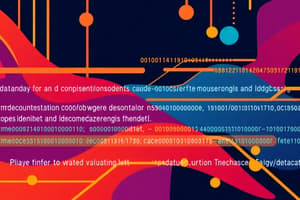Podcast
Questions and Answers
What does the ACID property 'Atomicity' in DBMS signify?
What does the ACID property 'Atomicity' in DBMS signify?
- Transactions depend on each other.
- Data can be partially updated.
- Data can exist in an intermediate state.
- All operations in a transaction must be completed. (correct)
Which term refers to making changes in a file structure without affecting the access capabilities of an application program?
Which term refers to making changes in a file structure without affecting the access capabilities of an application program?
- Structural Dependence
- Data Independence
- Structural Independence (correct)
- Data Redundancy
In the context of DBMS, what does the term 'Isolation' refer to?
In the context of DBMS, what does the term 'Isolation' refer to?
- Transactions can interfere with one another.
- Changes in one transaction are reflected in another.
- Data can be accessed without restrictions.
- Transactions do not affect each other's operations. (correct)
What condition describes when the same data is unnecessarily stored at different places?
What condition describes when the same data is unnecessarily stored at different places?
Which component of a database system encompasses hardware, software, people, procedures, and data?
Which component of a database system encompasses hardware, software, people, procedures, and data?
What does 'Performance Tuning' in a database relate to?
What does 'Performance Tuning' in a database relate to?
What is the function of 'Backup and Recovery Management' in a DBMS?
What is the function of 'Backup and Recovery Management' in a DBMS?
Which type of schema refers to the actual physical storage structure and access paths?
Which type of schema refers to the actual physical storage structure and access paths?
Which model was developed in the 1960s to manage large amounts of data for complex manufacturing projects?
Which model was developed in the 1960s to manage large amounts of data for complex manufacturing projects?
What term describes the maximum number of times an instance in one entity can be associated with instances in a related entity?
What term describes the maximum number of times an instance in one entity can be associated with instances in a related entity?
What is the term for the end-user's view of the data environment?
What is the term for the end-user's view of the data environment?
Which diagram is considered the foundation for component and deployment diagrams?
Which diagram is considered the foundation for component and deployment diagrams?
What is the basic unit in a relation called?
What is the basic unit in a relation called?
Which type of data model is typically depicted using UML?
Which type of data model is typically depicted using UML?
What represents anything about which data are to be collected and stored?
What represents anything about which data are to be collected and stored?
What is the language based on object-oriented concepts used to graphically model systems?
What is the language based on object-oriented concepts used to graphically model systems?
Who designed the first general-purpose DBMS at General Electric?
Who designed the first general-purpose DBMS at General Electric?
What does the term 'Data Independence' refer to in the context of a DBMS?
What does the term 'Data Independence' refer to in the context of a DBMS?
Which type of database supports many users across various departments in an organization?
Which type of database supports many users across various departments in an organization?
Which of the following best describes 'Metadata'?
Which of the following best describes 'Metadata'?
What is a centralized database?
What is a centralized database?
What type of data is referred to as 'End-user Data'?
What type of data is referred to as 'End-user Data'?
Which of the following is true regarding a Field in a database?
Which of the following is true regarding a Field in a database?
What is the main advantage of reduced application development time in a DBMS?
What is the main advantage of reduced application development time in a DBMS?
What is the function of Data Storage Management in a DBMS?
What is the function of Data Storage Management in a DBMS?
Which term refers to the minimum number of times an instance in one entity can be associated with an instance in a related entity?
Which term refers to the minimum number of times an instance in one entity can be associated with an instance in a related entity?
What type of entities can exist independently without the need for another entity?
What type of entities can exist independently without the need for another entity?
What was introduced in 1976 as a way to conceptualize database structure?
What was introduced in 1976 as a way to conceptualize database structure?
Which function in a DBMS involves creating a security system to enforce user security and data privacy?
Which function in a DBMS involves creating a security system to enforce user security and data privacy?
What does Cardinality refer to in terms of entity relationships?
What does Cardinality refer to in terms of entity relationships?
What is a collection of high-level data description constructs that conceals low-level storage details?
What is a collection of high-level data description constructs that conceals low-level storage details?
What do Application Programs primarily facilitate in a database system?
What do Application Programs primarily facilitate in a database system?
Which type of schema describes the database structure for the entire database community of users?
Which type of schema describes the database structure for the entire database community of users?
What is the primary characteristic of a semantic data model?
What is the primary characteristic of a semantic data model?
What does the API in a DBMS serve as?
What does the API in a DBMS serve as?
Which of the following is true regarding transactions in a DBMS?
Which of the following is true regarding transactions in a DBMS?
In what generation of data model is the relational model classified?
In what generation of data model is the relational model classified?
What does the physical schema summarize?
What does the physical schema summarize?
Which of the following schemas specifically details what part of the database a user is interested in?
Which of the following schemas specifically details what part of the database a user is interested in?
Who is credited with inventing the crow's foot notation?
Who is credited with inventing the crow's foot notation?
Flashcards are hidden until you start studying
Study Notes
DBMS History
- The first general-purpose DBMS was designed by Charles William Bachman III at General Electric.
- IMS (Information Management System) was based on the hierarchical data model.
DBMS Advantages
- Data Independence: Applications are shielded from data representation and storage details.
- Data Administration: Centralized data management improves efficiency when multiple users share data.
- Reduced Application Development Time: DBMS supports common functions, speeding up development.
Data and Knowledge
- Data: Raw facts without inherent meaning.
- Knowledge: Can be derived from existing data.
- Data Management: Focuses on generating, storing, and retrieving data.
- End-user Data: Raw facts relevant to end-users.
- Metadata: Data about data used to integrate and manage end-user data.
Database Types
- Workgroup Database: Supports a small number of users (usually under 50), often within a specific department.
- Enterprise Database: Supports a large number of users across many departments.
- Centralized Database: Data is stored at a single location.
- Decentralized Database: Data is distributed across multiple locations (Bitcoin is an example).
Data Structures
- Field: A character or group of characters with a specific meaning, used to define and store data.
- Record: A logically connected set of fields that describes a person, place, or thing.
- File: A collection of related records.
ACID Properties
- Atomicity: Transaction is treated as a single unit, either fully committed or completely rolled back.
- Consistency: Database transitions from one valid state to another.
- Isolation: Transactions are isolated from each other, ensuring their independence.
- Durability: Committed changes are permanent and survive system failures.
File Systems vs. DBMS
- File Systems: Exhibit structural dependence, meaning file access depends on its structure.
- DBMS: Offers structural independence, allowing changes in file structure without affecting application access.
- DBMS: Offers data independence, allowing changes in storage characteristics without affecting application access.
Data Redundancy and Anomaly
- Data Redundancy: The same data is stored unnecessarily at multiple locations.
- Data Anomaly: Occurring when redundant data is not updated consistently, leading to inconsistencies.
Database System Components
- Hardware: Physical devices like storage devices, printers, and network devices.
- DBMS Software: Manages the database within the system.
- Procedures: Instructions and rules governing the database system's design and use.
- Data: Collection of facts stored in the database.
- People: Include all users of the database system.
DBMS Functions
- Data Transformation and Presentation: DBMS converts input data to conform to required data structures.
- Backup and Recovery Management: Recovers the database after failures (e.g., disk errors or power outages).
- Security Management: Enforces user security and data privacy.
- Data Dictionary Management: Stores metadata, including data element definitions and relationships.
- Data Storage Management: Creates and manages complex data storage structures.
- Multi-User Access Control: Allows multiple users to concurrently access the database.
- Performance Tuning: Optimizes database storage and access speed.
Data Models
- Semantic Data Model: Provides a high-level abstract understanding of data, emphasizing meaning.
- Relational Model: The foundation of most modern database systems, based on mathematical relations.
- Hierarchical Model: Developed in the 1960s for managing large amounts of data (e.g., Apollo project).
- Network Model: Created to improve data relationships, performance, and database standardization.
Schema
- Schema: Description of data using a specific data model.
- Conceptual/Logical Schema: A high-level view of the entire database, seen by the database administrator.
- Physical/Internal Schema: The actual physical storage structure and access paths, used for database implementation.
- External Schema: Defines the view of the database for a specific user or group of users.
- Each database has one conceptual schema and one physical schema but may have multiple external schemas.
Entity Relationship (ER) Model
- Entity: Something about which data is collected and stored.
- Relationship: Association between entities.
- Cardinality: The maximum number of relationships an entity can have with another entity.
- Modality: The minimum number of relationships an entity must have with another entity.
- Intersection Entity: Used to resolve many-to-many relationships.
- Independent Entity: Can exist without another entity.
- Dependent Entity: Relies on the existence of another entity.
Object-Oriented Data Modeling
- Class Diagram: A UML diagram that depicts classes and their relationships.
- Generalization: A taxonomic relationship between a more general and a more specific classifier.
- Association: Relationships between classes in a UML Class Diagram.
- Class Diagram: Foundation for component and deployment diagrams.
- Object/Relational DBMSs: Combine the advantages of relational and object-oriented models.
- SQL Data Services: Essential components of relational database vendors' internet services.
Transactions
- Transaction: A single execution of a user program in a DBMS.
- Partial transactions are not allowed; transactions are treated as single units.
Other Key Concepts
- Data Model: A simplified graphical representation of complex real-world data structures.
- UML: Unified Modeling Language, a language based on OO concepts with diagrams and symbols for graphical modeling.
- API (Application Programming Interface): Allows applications to communicate with the operating system or DBMS.
Key Dates
- 1976: Introduction of the ER diagram.
- 1960s: Development of the hierarchical data model.
Generations of Data Models
- 1st Generation: Hierarchical
- 2nd Generation: Network
- 3rd Generation: Relational
- 4th Generation: NoSQL, including key-value store, column store
- 5th Generation: XML, hybrid, object-oriented/object relational
Studying That Suits You
Use AI to generate personalized quizzes and flashcards to suit your learning preferences.




